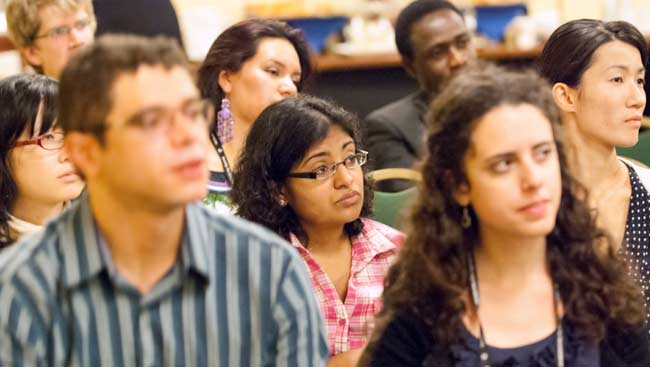Leveling the Playing Field: Improved Tenure and Promotion Practices Lead to a More Diverse Faculty

Attaining tenure and earning promotions are key milestones in an academic career. The process takes between five and seven years, and decisions are made based on a combination of research, teaching, and service to the academic community. For many female neuroscientists, however, achieving this goal can be a challenge. Although tenure and promotion committees strive to be objective, implicit bias — subtle discrimination based on cultural stereotypes — inadvertently enters into the decision-making process.
Leveling the playing field for all candidates requires a multi-pronged approach. First, it is crucial to offer all rising faculty members the same salary, space for research, teaching and committee assignments, and other resources so that promotion and tenure committees know that they are comparing faculty ”dealt the same hand” from the onset. Eliminating inequities also will make the job more appealing to all junior faculty members, giving them the motivation to continue on the tenure track. Second, offering numerous mentoring opportunities for women and other junior faculty members is essential. Without making these changes, underrepresented groups will be more likely to leave the professoriate. In fact, all faculty, especially women and other underrepresented junior faculty, benefit from structured approaches, such as providing regular feedback and mentoring programs that guide the career development of junior faculty.
The evidence is in the numbers. According to the 2011 CNDP/SfN survey, 40-50 percent of women leave the profession before making the transition to tenure-track faculty. Only 29 percent of tenured faculty at the level of associate professor are women, and only 25-28 percent are full professors. Because of this” leaky pipeline,” the growth of women in tenure-track faculty positions has been slow: In 2003 and 2005, the number was 25 percent; in 2007, it was 26 percent; and it stayed at 29 percent in 2009 and 2011.
As awareness of these problems has grown, many institutions are changing their practices. The Society for Neuroscience's ADVANCE/PAID Program, Department Chair Training to Increase Women in Neuroscience (IWiN), brought together department chairs from 43 institutions to learn how to improve their promotion and tenure review processes. The workshops have led to significant changes in institutions nationwide.
Steps Toward Tenure and Promotion
Most institutions have similar procedures in place for young faculty to be promoted and receive tenure. During the five- to seven-year process, junior faculty members have annual- and mid-career reviews to monitor their progress, ensure they are on track, and address problems as they arise. What can make the difference between success and failure for women and underrepresented candidates are strategies that guarantee equal treatment, and mentoring to help navigate this process. Furthermore, improved policies and practices can result in greater transparency, also making the process more equitable. The following sections identify the steps in the tenure and promotion process and what modifications IWiN participants have made.
Key steps are:
- Building a supportive culture
- Making expectations clear
- Incorporating mentoring into the process
- Conducting mid-career evaluations
- Making tenure review practices equitable
- Supporting promotion to full professor
Building a Supportive Culture
Institutions vary considerably in size and affiliated institutions. Each has its own culture, with a slightly different set of rules and regulations, as well as expectations, guiding faculty tenure and promotion. Despite these differences, however, they all must strive to create an open, friendly environment, where young faculty feel included and can find support when they need it.
- IWiN in Action: At Lehigh University, its campus is separated into two sections by a mountain. To ensure that women in the science, technology, engineering, and mathematics (STEM) departments know their colleagues on the other side of the mountain, they meet once a month to chat and share ideas. This has proven to be an effective way for young faculty to become integrated into the university and discuss concerns about teaching, grantwriting, and work/life balance.
Making Expectations Clear
It’s never too soon to tell new faculty members what they have to do to achieve tenure. Even during the interview, it’s not premature to begin to outline those expectations. Once an individual has been hired, the guidelines should be given in writing, with each step described. Examples of issues that should be covered include when to accomplish certain milestones and the kind of mentoring available.
Incorporating Mentoring into the Process
Many institutions have a mentoring program in place. A simple model is to assign a new faculty member to a mentor with whom they meet regularly — at least once a year — to discuss progress and places where improvement is needed. The mentor should try to be available any time the new hire would like to meet. The kind of advice given should involve reinforcing expectations and pointing out when it’s appropriate to say yes or no to various requests, such as serving on a committee or teaching an additional class.
On the informal side, junior faculty can reach out to different people both inside and outside their discipline, depending on the kind of advice they need. For example, if they need advice about writing grants and papers, one faculty member may be a good source of information, while another professor may be more knowledgeable about the expectations surrounding department/university citizenship. If a young faculty member’s research cuts across different disciplines, he/she may find it helpful to seek out a professor from a different department. Junior faculty members need to feel comfortable asking for help. In fact, it should become a lifelong practice.
- IWiN in Action: In the Spinal Cord and Brain Injury Center at the University of Kentucky Medical Center, mentoring is done by a team. Each junior faculty member is assigned a research mentor, a teaching mentor, and a mentor who looks at the big picture. The junior faculty member meets with the team twice a year and as needed. The team also reviews grants before they are submitted, provides feedback on setting up a lab, and reviews requirements needed for tenure and promotion. Importantly, the mentoring team is separate from the committee officially reviewing the junior faculty member for tenure, allowing this individual to be honest and open with his/her mentors. According to the associate director of the Brain Injury Center, the mentoring program is effectively serving to alleviate anxiety about the whole process.
- IWiN in Action: Working with the local chapter of the Association of Women in Science, the Louisiana State University Health Sciences Center held a ”speed mentoring” event. Female postdoctoral fellows and junior faculty rotated around a room, taking about 10 minutes to talk to senior faculty who were mostly women, about what they need to do to achieve tenure and be promoted. The event took place over lunch and lasted about two hours. ”It was a success and will be held again,” says one faculty member from the Neuroscience Center of Excellence. ”It was an opportunity for women to offer their help to other women.”
Conducting Mid-Career Evaluations
Institutions vary in how they handle mid-career evaluations. Many hold yearly meetings where a committee discusses with the junior faculty member how he or she is progressing along the tenure track. Junior faculty members should be prepared for a candid assessment of their work, which may include specific suggestions about how they can improve the quality of their papers and their teaching practices. The committee should also provide clear steps for implementing its suggestions, along with a timeline. There shouldn’t be any surprises when the junior faculty member goes up for final tenure review.
- IWiN in Action: Following the IWiN workshop, the Department of Ecology, Evolution, and Behavior at the University of Minnesota changed the way it conducted mid-career evaluations. Participants noted that junior faculty members were confusing professional development advice with mandatory changes they needed to make to receive tenure. By clearly differentiating the two kinds of advice, committee members went a long way to making junior faculty feel more positively about their mid-career evaluations.
Making Tenure Review Practices Equitable
One place where implicit bias can directly sabotage diverse candidates is during tenure review, when the junior faculty member has an opportunity to submit a dossier that highlights his or her most notable accomplishments. Typically, the dossier includes a personal statement, a curriculum vitae, a description of work accomplished, papers published, a teaching portfolio, and letters of recommendation. Although the dossier is a written record of what the individual has accomplished, the people reviewing the file — and the criteria used to assess it — can make a difference in the final outcome.
Two studies, one conducted in 2003 at Wayne State University and a second one completed in 2007 at the University of Arizona, showed that the recommendation letters for women were significantly weaker than those for men. The Wayne State study found that women were typically described as “thoughtful” and ”considerate,” whereas men were described as ”intelligent” and “productive.” The findings from the 2007 study were similar, pointing out that men were described as ”superb” and “remarkable,” while women were ”hard-working” and “conscientious.” The implicit gender bias article has more information about these studies. Because of concerns like these, it is essential to incorporate safeguards into the review process.
- IWiN in Action: At the University of Minnesota, one department overhauled the organization of the tenure committee. Instead of delegating the task to three or four people and having them develop a report for the rest of the faculty, the entire department now reviews the file. The department’s focus is on arriving at answers to the following questions:
- Is the person's research on track for tenure?
- Is the person's teaching on track for tenure?
- Is the person's outreach work on track for tenure?
Faculty responses must be clear and list specific examples; if not, they are sent back to the faculty member for revision. The individual up for tenure receives a copy of the report, which provides information on progress to date. When it comes time to make the final decision, everyone in the department casts a vote. “The system seems to be working,” says one department chair. “Everyone who has been up for tenure has received it in the three years since we made these changes. And the meetings are a lot more enjoyable, too.”
- IWiN in Action: Another innovation that helps level the playing field is ”stopping the clock.” Situations that justify this practice include the birth of a child, caring for an elderly parent, or a family illness. This policy allows a junior faculty member to extend the timeline for going up for tenure without being penalized. At the University of Kentucky Medical Center, this practice has been in place for a few years, with both men and women taking advantage of this option.
Supporting Promotion to Full Professor
Achieving tenure is a huge accomplishment, but it is not the end of the road. The largest hurdle facing associate professors is being promoted to full professor. Realizing that goal requires the faculty member to:
- Be willing to take on more professional responsibilities: This may include active participation in scholarly societies, peer review of grant applications and serving on editorial boards.
- Become a more engaged citizen of the institution: Serving on task forces or academic senate and participating in special events.
- Continue to seek out advice from senior faculty: Working with mentors never stops. There is always something to learn from seasoned professors.
- IWiN in Action: The Ohio State University has developed two brochures on this subject. (Links to these brochures are in the “For Further Reading” section.) One is a guide for associate professors as they work toward the next level. The second is for full professors, explaining clearly their role in helping their junior colleagues’ progress. This kind of information helps make the process easier for everyone.
Although these strategies have only been implemented in the last few years, institutions have already begun to see results. For example, at The Ohio State University, 18 percent of chairs are women, as are 33 percent of the deans and 40 percent of top administrators. At the University of Kentucky Medical Center, 71 percent of department heads are women.
What’s even more exciting, however, is the culture change taking place. As one department chair put it, "We’re embracing best practices, and we're seeing our institution flourish.”
For further reading:
Burnham JJ, Hooper LM, Wright VH. Top 10 Strategies for Preparing the Annual Tenure and Promotion Dossier. Faculty Focus: Higher Ed Teaching Strategies from Magna Publications. April 25, 2012. http://www.facultyfocus.com/articles/faculty-evaluation/top-10-strategies-for-preparing-the-annual-tenure-and-promotion-dossier/
Ohio State University. Moving Forward in Your Faculty Career.
http://oaa.osu.edu/assets/files/documents/PromotionGuideAssociateProfessors.pdf
Ohio State University. Supporting Promotion to Full Professor.
https://oaa.osu.edu/sites/default/files/uploads/faculty-development/ProvidingLeadershipForFacultyPromotion.pdf
Valian V. Recruitment and Retention: Guidelines for Chairs.
http://www.ccas.net/files/ADVANCE/recruitretain.pdf







